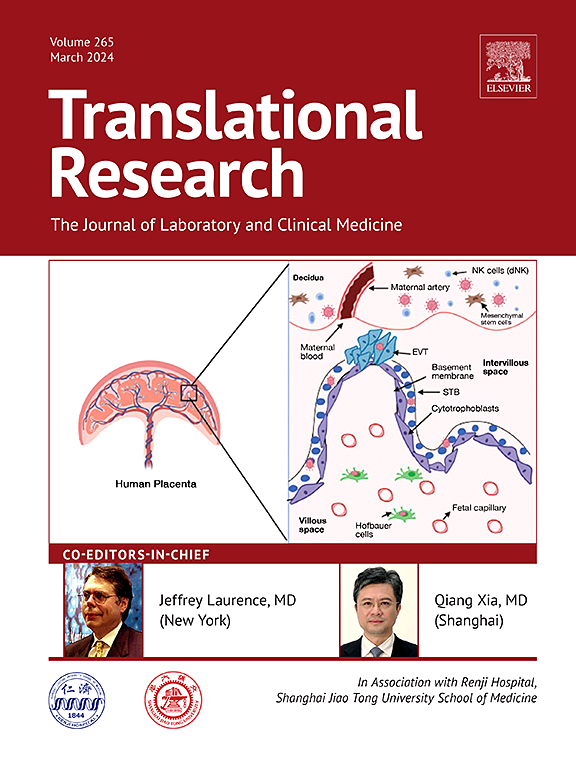Abundance of dopamine and its receptors in the brain and adipose tissue following diet-induced obesity or caloric restriction
IF 5.9
2区 医学
Q1 MEDICAL LABORATORY TECHNOLOGY
引用次数: 0
Abstract
While obesity and type 2 diabetes (T2D) are associated with altered dopaminergic activity in the central nervous system and in adipose tissue (AT), the directions and underlying mechanisms remain inconclusive. Therefore, we characterized changes in the abundance of dopamine, its metabolites, and receptors DRD1 and DRD2 in the brain and AT upon dietary intervention or obesity. Male Wistar rats were fed either a standard pellet diet, a cafeteria diet inducing obesity and insulin resistance, or a calorie-restricted diet for 12 weeks. Abundance of dopamine and its receptors DRD1 and DRD2 were examined in brain regions relevant for feeding behavior and energy homeostasis. Furthermore, DRD1 and DRD2 protein levels were analyzed in rat inguinal and epidydimal AT and in human subcutaneous and omental AT from individuals with or without obesity. Rats with diet-induced obesity displayed higher dopamine levels, as well as DRD1 or DRD2 receptor levels in the caudate putamen and the nucleus accumbens core. Surprisingly, caloric restriction induced similar changes in DRD1 and DRD2, but not in dopamine levels, in the brain. Both diets reduced DRD1 abundance in inguinal and epidydimal AT, but upregulated DRD2 levels in inguinal AT. Furthermore, in human obesity, DRD1 protein levels were elevated only in omental AT, while DRD2 was upregulated in both omental and subcutaneous AT. These findings highlight dopaminergic responses to changes in energy balance, occurring both in the brain and AT. We propose that dopaminergic pathways are involved in tissue crosstalk during the development of obesity and T2D.
饮食引起的肥胖或热量限制后大脑和脂肪组织中多巴胺及其受体的丰度
虽然肥胖和2型糖尿病(T2D)与中枢神经系统和脂肪组织(AT)中多巴胺能活性的改变有关,但其方向和潜在机制尚不明确。因此,我们表征了饮食干预或肥胖后大脑和AT中多巴胺、多巴胺代谢物以及受体DRD1和DRD2丰度的变化。雄性Wistar大鼠被喂食标准颗粒饮食、导致肥胖和胰岛素抵抗的自助餐厅饮食或限制卡路里饮食,为期12周。多巴胺及其受体DRD1和DRD2的丰度在与摄食行为和能量稳态相关的大脑区域被检测。此外,还分析了肥胖或非肥胖个体大鼠腹股沟和附睾AT以及人皮下和网膜AT中DRD1和DRD2蛋白水平。饮食诱导肥胖的大鼠显示出更高的多巴胺水平,以及尾状壳核和伏隔核核心的DRD1或DRD2受体水平。令人惊讶的是,热量限制引起了大脑中DRD1和DRD2的类似变化,但没有引起多巴胺水平的变化。两种饮食均降低了腹股沟和附睾AT中DRD1的丰度,但上调了腹股沟AT中DRD2的水平。此外,在人类肥胖中,DRD1蛋白水平仅在网膜AT中升高,而DRD2在网膜和皮下AT中均上调。这些发现强调了多巴胺能对能量平衡变化的反应,发生在大脑和AT中。我们认为多巴胺能通路在肥胖和T2D的发展过程中参与了组织串扰。
本文章由计算机程序翻译,如有差异,请以英文原文为准。
求助全文
约1分钟内获得全文
求助全文
来源期刊

Translational Research
医学-医学:内科
CiteScore
15.70
自引率
0.00%
发文量
195
审稿时长
14 days
期刊介绍:
Translational Research (formerly The Journal of Laboratory and Clinical Medicine) delivers original investigations in the broad fields of laboratory, clinical, and public health research. Published monthly since 1915, it keeps readers up-to-date on significant biomedical research from all subspecialties of medicine.
 求助内容:
求助内容: 应助结果提醒方式:
应助结果提醒方式:


